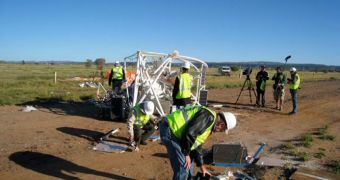After more than a year from the April 28, 2009 incident in which a massive balloon crashed, taking with it an advanced astronomical telescope, a NASA review board releases the conclusions of its investigations into the matter.
A scientific balloon was supposed to launch from Alice Springs, Australia last year, carrying on board the Nuclear Compton Telescope (NCT), a gamma-ray observatory developed by researchers at the University of California in Berkeley.
But the launch process was unsuccessful, and the telescope ended up partially destroyed, after people who attended the launch narrowly avoided being injured at the launch site.
NASA investigators wanted to know precisely what went wrong, and so they opened a full-scale investigation into the issue, which saw experts browse through vast amounts of data.
Panel members looked over technical reports, weather reports, and conducted exhaustive interviews with numerous eyewitnesses to the events.
During the launch process, the NCT payload, which was attached to a mobile crane used for the launch, separated from its enclosure, and ended up being dragged by the massive balloon over a distance of 150 yards.
During this time, it passed close to numerous onlookers, but fortunately no one got hurt. The payload then smashed through a fence and totaled an unoccupied car in a nearby lot.
Experts with the NASA Mishap Investigation Board identified 25 proximate, intermediate and root causes for the incident, and made 44 recommendations based on these findings.
The issues that were discovered were related to insufficient risk analysis, contingency planning, personnel training, technical knowledge, government oversight and public safety accommodations.
“There is no question in our minds that balloon launches are fragile processes,” explains NASA Goddard Space Flight Center expert and board leader Michael L. Weiss.
“The mishap board reviewed a large volume of information about the accident and conducted numerous interviews with eyewitnesses,” he adds.
“But in the course of our investigation, we found surprisingly few documented procedures for balloon launches. No one considered the launch phase to be a potential hazard,” the official says.
“We have learned a lot from this incident, and we'll have a better balloon program because of it,” concludes GSFC director Rob Strain.

 14 DAY TRIAL //
14 DAY TRIAL //